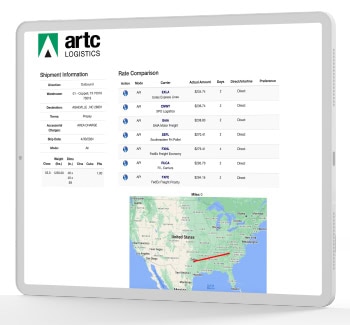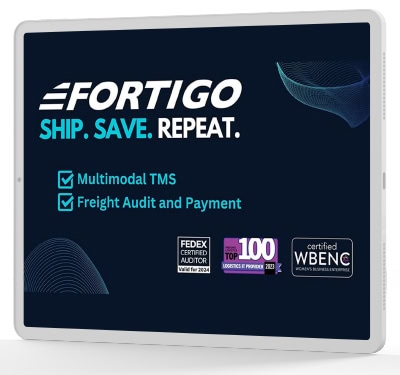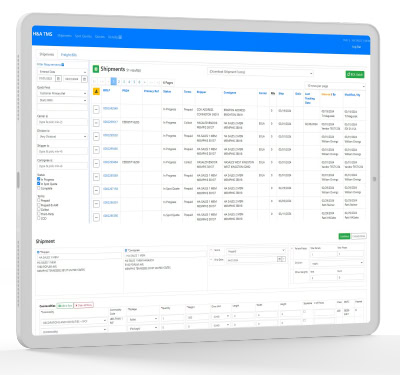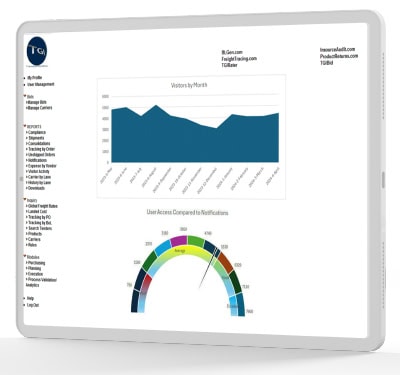The Indispensable Edge: TMS Empowers Shippers in a Competitive Landscape

Stop pushing boxes. For companies looking to get ahead, a Transportation Management System (TMS) is no longer a luxury, it’s a necessity. Leading TMS providers offer solutions and innovations to propel shippers toward efficiency, cost reduction, and superior service delivery.
A robust transportation management system is one of the most powerful weapons that a shipper can wield today.
“In the intricate web of modern supply chains, the role of transportation management systems is pivotal, acting as the backbone that ensures the seamless movement of goods from origin to destination,” says Alan Miller, president of TransportGistics, a global logistics solutions provider.
Transportation management systems have long played a central role in the supply chain, but that role has become increasingly vital as shippers, technology, and the global supply chain continue to evolve and grow more sophisticated.
“What a TMS does is becoming more and more important, particularly for companies that operate on a global scale,” says Stewart Dunsmore, senior vice president, supply chain services, for freight audit service company nVision Global.
“An effective TMS is more critical now than it has ever been,” agrees Spencer Gore, vice president, operations excellence, with CTSI-Global, a provider of supply chain technology services.
“With the current market volatility, organizations are facing increased shipping costs, as well as shipment delays,” Gore notes. “To combat that, organizations need real-time data, a wide carrier base, and access to all available shipping options to meet their specific supply chain needs, whether that’s reduced cost or faster transit times.”
An effective TMS is not merely critical in today’s complex and fast-paced supply chain environment—it’s indispensable.
“Shippers face a multitude of challenges ranging from rising costs due to inflation and spiking demand as well as trade and compliance regulations, while still needing to run a lean just-in-time organization,” says Parker Stallard, president of Argus Logistics, a full- platform logistics management firm.
“An effective TMS provides the backbone for meeting these challenges by enhancing efficiency, reducing costs, and improving service delivery,” he says.
An Essential Tool

Using a TMS, shippers can plan the loading space of trucks, trailers, and containers and receive a calculation of the available loading space.
A TMS is essential for a variety of reasons, ranging from enhanced visibility and better decision-making to managing compliance and regulation.
“In today’s competitive and rapidly evolving supply chain environment, an effective TMS is no longer a luxury but a necessity for shippers looking to stay ahead, drive efficiency, reduce costs, and deliver exceptional customer experiences,” says George Kontoravdis, president of Fortigo.
Investing in an effective, robust TMS makes even more sense when considered alongside how much shippers pay to move their freight.
“With freight expense usually between the third or fourth largest category of costs, depending on the company, if you don’t have a handle on it, your costs could be out of control,” says Nick Fisher, director of sales for ARTC Logistics, which provides advanced transportation management software.
A TMS is “paramount for shippers,” notes Austin Long, project manager for freight management solutions provider Hatfield & Associates. “As global trade complexities increase, shippers face mounting pressures to streamline operations, reduce costs, and enhance customer satisfaction.
“A robust TMS serves as a strategic tool, enabling shippers to optimize routes, consolidate shipments, track freight in real time, and mitigate risks effectively,” Long says. “It empowers decision-makers with data-driven insights, fostering agility and responsiveness to dynamic market conditions.
“With heightened competition and evolving customer expectations, an efficient TMS isn’t merely advantageous; it’s indispensable for shippers striving to maintain competitiveness and achieve supply chain excellence in today’s fast-paced environment,” he adds.
Transportation management systems have developed into holistic solutions, making them more easily integrated into an organization’s supply chain.
“In the past, our customers would use a TMS to meet one or two needs—whether rate shopping or shipment tracking. But in recent years, a TMS has evolved to allow shippers to integrate it as an extension of their supply chain that touches all areas of shipping,” Gore says.
In the past few years, TMS solutions have made most data accessible via the cloud, and most carriers have adopted technology that the TMS can tie into so that “shippers and carriers can quickly share information,” Fisher says.
Today, TMS customers seek real-time visibility that provides “breadcrumb tracking,” allowing them to gain more control and improve event management during the shipment cycle, says Kevvon Burdette, chief commercial officer for transportation technology provider Princeton TMX.
Performance Metrics
In addition, shippers emphasize the importance of benchmarking metrics within their TMS to measure the effectiveness of their procurement strategies compared to the market and to weigh how their transportation network performs in comparison to their peers.
The integration of predictive analytics and AI also helps a TMS optimize operations and anticipate demand, while sustainability initiatives drive the prioritizing of fuel efficiency and emission reduction.
“These advancements reflect the industry’s focus on efficiency, visibility, and sustainability, shaping the future of transportation management,” Long says.
Artificial intelligence is bringing a profoundly new dynamic to the TMS field.
“AI is not helping just with analytics to manage transportation costs, route optimization, and delivery times. It’s also getting more prescriptive as the technology matures,” Burdette says. “It’s one thing to understand proactively if a shipment will be late. But by moving from predictive to prescriptive analysis utilizing AI tools, shippers will gain insights and receive intelligent recommendations on the optimal action to take for any particular shipment.”
Here are some leading TMS providers whose solutions are adapting to new supply chain challenges and creating advantages and opportunities for the shippers who use them.
Argus Logistics: Easing Pain Points, Driving Gains

The Argus Logistics proprietary cloud-based TMS enables seamless shipping, reporting, cost allocation, and shipment visibility in real time.
In today’s supply chain marketplace, Argus Logistics’ TMS stands out due to its comprehensive integration capabilities, modular design, and emphasis on real-time, actionable insights.
“Our TMS effectively addresses the specific pain points of each client through customizable modules that cater to diverse logistical needs, from route optimization and carrier management to freight bill audit and pay,” says Parker Stallard, president of the Detroit-based company.
“This customization allows for a highly tailored approach that fits each client’s unique requirements, making our TMS exceptionally effective,” he adds.
Key benefits of the Argus TMS include dramatic enhancements in operational efficiency, cost reductions, and improved shipment visibility.
The evolution of the TMS ecosystem in recent years has been marked by major technological advancements in areas such as artificial intelligence, machine learning, and real-time data analytics, Stallard notes. These technologies have transformed TMS from a mere operational tool to a strategic asset that offers predictive insights and proactive management capabilities.
“At Argus, we’ve harnessed these technologies to ensure our TMS not only manages logistics but also predicts trends and adapts to changes dynamically, providing a robust tool that supports decision-making and continuous improvement,” Stallard says.
The Argus TMS client base is diverse, ranging from mid-sized shippers to large multinationals across various sectors including manufacturing, retail, chemical, consumer electronics, and industrial distribution. These clients typically seek solutions for complex challenges such as cost management, compliance with global shipping regulations, and enhancing supply chain transparency.
“Our TMS is designed to tackle these issues by providing detailed insights and control mechanisms that streamline operations and improve compliance across global markets,” Stallard says.
One standout feature of the Argus TMS is its advanced algorithmic framework that optimizes shipment planning and routing and helps account for many dynamic variables such as volume shifts, loading and unloading delays as they relate to hours-of-service regulations, and ever-changing traffic patterns affected by weather conditions.
“This dynamic rerouting capability ensures that transportation is not just efficient but also highly adaptable to the unpredictability of global logistics,” Stallard says.
In addition, the Argus system integrates seamlessly with clients’ existing ERP systems, enhancing data fidelity and reducing the risk of data silos that can impede decision-making.
The TMS features an enhanced freight settlement module that automates and streamlines the payment and audit processes, reducing discrepancies and improving financial accuracy. Argus also offers control-tower visibility that allows shippers to manage their transportation needs with precision and agility.
Another key feature is the incorporation of robust compliance tools that address both domestic and international shipping regulations. This feature is crucial for clients operating across borders, ensuring that they remain compliant with varying regulations without manual oversight, which is a critical aspect often overlooked in standard TMS offerings.
“These elements collectively ensure that Argus Logistics’ TMS is not only a tool for visibility and operational control but also a strategic asset that can drive significant improvements in cost, efficiency, and compliance across the supply chain,” Stallard says.
ARTC Logistics: Flexibility to Meet Unique Needs

The ARTC Logistics TMS can share rate comparisons for shippers.
If there’s one word to explain what makes ARTC Logistics’ transportation management system distinctive, it is “flexibility,” says Nick Fisher, director of sales with the New York-based company. For instance, ARTC’s TMS is designed in a modular fashion, breaking down the components of individual functions so that customers can pick and choose those pieces that best fit their needs.
“We have clients who prefer to maintain their data ‘on-prem’ with software they install and integrate with their ERP and WMS applications, while others prefer a 100% hosted environment with ARTC managing software updates. Yet others prefer a hybrid deployment,” Fisher explains. “We accommodate all of those deployment scenarios.”
In addition, not only does ARTC’s TMS support the API functionality that carriers offer, but it also provides the capability for its clients to store, maintain, and update information that might not be available from the carrier’s API or that the shipper might prefer to manage themselves, such as freight rates.
Inbound vs. Outbound Control
The control of inbound freight costs versus outbound freight costs is typically overlooked when weighing a TMS, Fisher says. Shippers tend to focus on outbound freight costs because they can easily control them.
“But when shippers attempt to manage freight costs and get that information from suppliers shipping products to them, or when they have to issue returns from existing customers, it is difficult to manage,” he says. “We have a good mousetrap that handles the control of inbound freight spend and planning.”
Another advantage of the ARTC Logistics’ TMS is its “what-if” function that allows clients to analyze the freight impact of potential changes in their supply chain—whether those changes are forced by an external impact or a shipper is looking to make a shift in strategy.
As an example, if they were to move a facility from point A to point B, or open a new facility, within minutes ARTC could give them some definitive expectations of that cost impact. This is similar to what ARTC can do when a carrier submits a new bid when its customers are negotiating.
ARTC also has some comprehensive tools that allow customers to understand the potential impact if one or more of their carriers change their freight rates. It is not uncommon to hire high-priced consultants who spend weeks of time and charge top dollar for that type of analysis; ARTC’s clients can quickly go into the ARTC tool, plug in their changing parameters, and have the system spit out a solution.
ARTC Logistics’ TMS clients include manufacturers and distributors doing outbound, inbound, or interplant shipping. They represent a wide range of commodities, with a focus on intra-North America over-the-road shipping.
“If you are making a widget or shipping boxes to the company manufacturing the widget and you have freight expenses, ARTC can handle your needs,” Fisher concludes.
CTSI-Global: Customization Provides the Buzz

CTSI-Global’s Honeybee TMS is customizable to meet the specific needs of shippers and to address any challenges that arise.
CTSI-Global’s Honeybee TMS was developed based on the company’s understanding that its customers are all different and the ways those customers use a TMS will be different, too.
“We’ve got a team of TMS experts who know the industry and work directly with our customers and their carriers to customize our TMS to meet their needs and address any challenges that arise,” says Spencer Gore, vice president, operations excellence (CoE).
“We’ve developed our own TMS tools in-house, which gives us great flexibility when it comes to those implementations and allows us to focus the tools on each specific customer and what they need,” he adds.
That includes giving clients powerful tools to make savvy, prompt adjustments when supply chain obstacles emerge.
“Our real-time analytics provide insight that allows customers to reroute shipments currently in transit or to book shipments with alternative modes when needed,” Gore says. “In addition to those analytics, customers can use the Honeybee TMS to understand the impact from a cost standpoint, which allows them to make more informed decisions when selecting a carrier to move their freight.”
Zeroing in on Parcel Shipping
In recent years, CTSI-Global particularly has focused on increasing its bandwidth for parcel shipments.
“We have developed parcel shipping tools that allow customers to optimize and ship both domestically and internationally as well as to track those parcel shipments in real time from ship date all the way to delivery,” Gore says.
“In addition to large parcel shipping companies such as UPS, FedEx, and DHL, our TMS is also connected with smaller regional carriers, which gives our customers increased flexibility when it comes to selecting a parcel carrier.
“Our TMS parcel solutions allow customers to view all possible parcel carrier options, select the appropriate carrier based on shipping cost and transit time, print shipping labels directly from our website and then track those shipments in real time,” he adds.
Control Tower power
CTSI-Global has added control tower services to its TMS offering in the past three years.
“Our dedicated teams on site at customer facilities oversee customer shipping volumes, work directly with their current carriers to book shipments, track those shipments using the Honeybee TMS in real time, and make decisions to reroute those shipments based on our analytics,” Gore says.
Honeybee has a wide customer base representing a range of industries. Among its clients is a large medical device company that ships around the world. Some of the company’s shipments are extremely time sensitive. CTSI-Global has dedicated teams monitoring the company’s activity 24 hours a day. They ensure shipments are optimized and booked and sent back to the customer’s ERP within set time limits, guaranteeing medical devices that are urgently needed are ready for shipment on time.
It’s an example of Honeybee’s versatility in action, and CTSI-Global’s determination to serve each client individually.
“We’re able to support any and all supply chain operations,” Gore says. “Whether it is a global organization or a smaller, single-country-based organization with very specific supply chain challenges, we’re able to customize our tools and our approach to meet their needs.”
Fortigo: Dedicated to Supply Chain Innovation

Fortigo is committed to continuous customer-oriented improvement and innovation in its TMS solution.
Given the rapid changes in today’s supply chain environment, shippers need a transportation management system that evolves with it. The Fortigo TMS has significantly evolved in recent years, primarily through technology advancements and changing market dynamics.
“We are committed to continuous customer-oriented improvement and innovation in our TMS solution,” says George Kontoravdis, president of Fortigo, an Austin, Texas-based logistics software-as-a-service company. “We regularly enhance the platform based on the latest innovations and industry trends, ensuring we remain at the forefront of transportation management technology.
“In the last year alone, we deployed over 80 enhancements to elevate our robust TMS capabilities,” he notes. “With core focuses on efficiency and agility, our TMS simplifies the complexities of modern supply chains.”
Additionally, Fortigo added AI-driven spend dashboards that maximize visibility and empower shippers’ supply chain data by tracking carrier performance and spend trends, and utilizing more than 200 customizable TMS reports.
Fortigo customers are generally large, multinational companies—including the world’s three largest airlines—with complex constraints and global shipping across all geographies, using multiple modes of transportation. The Fortigo TMS offers an array of key benefits that make it highly effective in today’s dynamic supply chain environment.
“Our TMS provides end-to-end visibility into transportation activities, allowing users to track shipments in real time and monitor key performance metrics,” Kontoravdis says. “This visibility enables proactive decision-making and exception management.”
Fortigo’s TMS also excels at optimization capabilities, leveraging advanced optimization algorithms to maximize efficiency and cost savings throughout the supply chain. The TMS considers factors such as routing, mode selection, carrier rates, and service levels to identify the most cost effective transportation options while following all enterprise business rules.
In addition, the Fortigo TMS offers robust support for multimodal transportation, which allows users to seamlessly plan and execute shipments across different modes of transport.
“This flexibility enables shippers to leverage a combination of transportation modes to meet their specific needs while optimizing costs and transit times,” Kontoravdis says.
The Fortigo TMS seamlessly integrates with other supply chain management systems, including WMS and ERP platforms. This integration ensures data consistency and enables collaboration across different supply chain functions, enhancing overall efficiency and visibility.
Scalability and flexibility are important factors in the ability of the Fortigo TMS to adapt to changing conditions.
“Our TMS is built on a scalable architecture, allowing it to grow and adapt to customers’ changing needs,” Kontoravdis says. “Whether managing a small volume of shipments or a large, complex transportation network, our TMS can accommodate any level of demand and scale accordingly.”
Closed Loop Solution
Pairing Fortigo’s TMS with its Freight Audit solution creates a closed-loop supply chain solution that optimizes efficiency and enhances cost control throughout the transportation lifecycle.
“Fortigo’s TMS streamlines the planning, execution, and monitoring of transportation operations, providing end-to-end visibility and control over shipments,” Kontoravdis says. “Our Freight Audit solution allows companies to automate the audit and payment process, ensuring accuracy and compliance while minimizing errors and discrepancies in freight invoices.
“By pairing Fortigo’s TMS with their Freight Audit solution, companies can achieve greater efficiency, accuracy, and cost savings across their transportation operations, ultimately driving toward a more agile and proactive supply chain,” he says.
Hatfield & Associates: Customization Takes Priority

Hatfield & Associates’ TMS provides comprehensive details about each shipment, while real-time shipment tracking information allows users to monitor the status and location of each shipment as it moves through the supply chain.
Shippers who use Hatfield & Associates’ transportation management software know that they have the advantage of using a solution that can be tailored to their unique needs.
Hatfield can customize any aspect of its TMS software to fit its clients’ preferences, says Austin Long, project manager. “Our software is owned and maintained in house,” he notes, at Hatfield’s corporate headquarters in Memphis, Tennessee. All programming is performed in house, too, and each account is assigned an account manager to assist with any issue that a client might face. The company even offers integration staff who speak both English and Spanish.
The Hatfield TMS provides management of programming rates, audit and payables, and a spot quote portal/bid board. The TMS also communicates with Hatfield’s business intelligence platform for reviews of key performance indicators and with its vendor portal platform for inbound freight management. The business intelligence platform looks at any KPI that a company uses and provides visibility to them with reporting and data analysis.
Meanwhile, Hatfield can tailor vendor portals based on what a client wants to see on its dashboards, ensuring high levels of visibility on the details most important to them through Hatfield’s robust tracking-and-tracing capabilities.
Hatfield’s clients include both publicly owned and privately owned companies and both manufacturers and wholesalers.
“The challenges they face include controlling inbound freight from suppliers to warehouses for manufacturing,” Long says. “The most challenging part is visibility of their inbound freight from suppliers and controlling costs associated with supplier movements. Our vendor portal solves this issue and is a platform that communicates to our TMS.”
TMS Success Story
One Hatfield client is a manufacturer who works with more than 450 different suppliers. Before its partnership with Hatfield began, the client struggled to control routings, costs, and correct carrier usage using its internal tools. It also had poor visibility into how its hundreds of different suppliers were managing their transportation and freight. Resulting pain points included incorrect charges, wrong classifications and improper carrier selection. Inefficiencies abounded.
The client then adopted Hatfield’s vendor portal to route inbound freight and its TMS to manage a variety of tasks, such as shipments, getting rates, and dispatching carriers.
Hatfield’s TMS includes models called “bid boards” or “e quotes” that allow the client to input the specifications for a load and submit a bid to the market to see which carrier is the cheapest and then tender the load to that carrier. In addition, the TMS can be bolted onto an enterprise resource system (ERP) so that the TMS can share data about how a shipment should be routed.
The client now saves about 30% on its transportation costs and enjoys visibility into all its inbound freight, as well as the costs associated with those freight movements.
“The company uses our TMS for all of its outbound freight and to select the lowest-cost carriers available,” says Jack Hatfield, founder and president, Hatfield & Associates. “It also has visibility to their inbound for compliance, which is critical to ensuring that vendors actually select the least-cost carrier and not go around them. There’s compliance on both sides: inbound and outbound.”
nVision Global: Meeting Demands Around the World

nVision’s Impact TMS allows users to plan, organize, and manage all global shipments in one easy-to-use solution.
While many transportation management systems can manage domestic shipping, nVision Global stands out in the marketplace by having “a truly global TMS,” says Stewart Dunsmore, senior vice president, supply chain services.
That label stems in part from the capability of nVision Global’s Impact TMS that allows global clients to manage their regional movements with local currencies, while viewing their supply chain data in their native currency.
For instance, a European-based customer with operations in Asia and North America can execute shipments with the currencies of those regions, but then manage them centrally using euros as their reporting currency.
“We offer a global freight management solution to the marketplace,” says Dunsmore.
“nVision Global emphasizes understanding the specific challenges that a business faces and cultivating solutions around those challenges,” he adds. “Our rate engines allow customers to rate shipments based on multiple transportation modes.
“nVision features a spot auction tool that is global in nature, but also has a regional component that allows clients to go to the spot market to get rates and compare those rates to their contracted rates,” Dunsmore notes.
In addition, nVision’s insight analytics tools measure every aspect of clients’ supply chains and the costs associated with them, helping shippers to manage costs and make decisions on how best to optimize various aspects within their supply chain to maximize efficiency at the lowest cost.
“When you use our TMS, you have the ability to do a ‘least cost’ rating for a single service mode or cargo type, as well as a ‘least cost’ rating for multiple cargo types so that you can see all the comparisons and make the right decision for that movement,” Dunsmore says.
“Internationally, you can compare intermodal to ocean to air and select the most competitive rates based on your existing contracts,” he adds.
Expanded Customer Base
“As of just three years ago, nVision’s TMS clients were focused mainly in the technology and industrial oil and gas sectors, but the company has expanded its customer base to medical, retail, and food spaces, while also expanding solutions within Asia and Europe,” according to Dunsmore.
“Because we focus on configuring our software to a customer application, we gain an advantage going into new markets because we’re used to being able to adapt and configure the software to meet different business processes,” he says.
“nVision’s global presence means that it does not merely offer services in international regions; it has the resources to support those services in the field,” Dunsmore notes.
“We have a global infrastructure, so when a customer’s suppliers come into our environment to create inbound shipments destined to our customers, we have control towers inside the global regions to support those suppliers.
“We train them in their own languages. We allow our tools to be configured in every language globally, so that the users actually see the header information in their language. Having those resources globally in China and Singapore and in Europe and in South America, keeps us always in close contact to support our customers’ trading partners,” Dunsmore notes.
Princeton TMX: Emphasizing the User Experience

Princeton TMX’s transportation management system optimizes freight spend by enabling users to automatically request quotes, compare rates, and assign loads.
For Princeton TMX’s transportation management system, the quality of the user experience is always a primary concern.
Princeton TMX stresses understanding the experience of its clients’ team members who use the company’s TMS daily. That means focusing on elements such as the simplicity of adopting the TMS and the efficiency and intuitiveness of its workflow.
“We find that the degree to which your user interface is easy to use improves the adoption rate from within the shipper community,” says Kevvon Burdette, chief commercial officer of the Fort Wayne, Indiana-based company. “You also want to simplify transactions as much as possible to create an inherent workflow within the TMS that shippers can easily relate to.”
In addition, Burdette says, Princeton TMX targets improving not only the shipper experience but also the carrier one. That’s because when carriers have a great experience working with a shipper, such as via the technology tools that the shipper uses, then they are more likely to embrace opportunities to work with that shipper in the future.
“We focus on a good carrier experience, as well as on some little things in our system that were built with the shipper and carrier relationship in mind to make it easy for them to work together,” Burdette says. “That’s important to us.”
That emphasis includes a comprehensive mobile app that is part of the TMS and that both shippers and carriers use. It also means the TMS is multimodal, including both truck and rail capabilities, with plans to introduce barge capabilities later in 2024.
Princeton TMX’s customer base includes those working in lumber and building supplies, mining and raw materials, metals, and paper and packaging; the company also is expanding into the food and beverage space. Those customers lean on different transportation modes to get materials and products where they need to go.
“We stress being able to execute different transportation modes within the TMS so you don’t have to go to disparate systems or sign out to sign onto another system,” Burdette says. “It’s important to us that clients can do everything they need in our system.”
In addition, Princeton TMX released a sustainability module, an enhancement that will help shippers who are looking to strengthen operations in that area. Burdette says the TMS will provide metrics around sustainability at the point of execution, which can help shippers weigh sustainability when making decisions about transportation options. This is one example of the role data from Princeton TMX’s TMS can play in supporting shippers.
“We move more data than we do shipments today. Customers are looking not only for the data but also how they can use the data to make decisions, improve forecasting and get a big picture of their overall network,” Burdette says. “That’s what we help them to do.”
TransportGistics: Helping Shippers Prioritize Compliance

TransportGistics’ TMS solution is equipped with robust compliance capabilities and enforces standards and regulations across the supply chain.
In the complex world of the modern supply chain, transportation management systems serve a critical purpose, ensuring that goods flow in the most efficient, optimal way possible.
Within that framework, supplier compliance is a critical component of an effective TMS, serving as the linchpin for operational efficiency, cost-effectiveness and customer satisfaction, notes Alan Miller, president of TransportGistics, based in Mount Sinai, New York.
TransportGistics’ TMS solution (TGI-TMS) features tools that allow shippers to prioritize compliance and excel in that critical component of managing their supply chains.
“TGI-TMS is equipped with robust compliance capabilities and enforces standards and regulations across the supply chain, mitigating risks associated with delays, penalties, and reputational damage,” Miller says. “Our solution ensures that all parties adhere to agreed-upon terms—from shipping protocols to delivery timelines—fostering a harmonious and predictable flow of operations.”
Non-Compliance Can Be Costly
Taking an inadequate approach to compliance can be costly. “Simply negotiating, executing, and implementing new transportation rates and pricing does not guarantee delivery of the anticipated cost savings,” Miller says. “A lack of compliance and nonstandard business processes costs companies millions of dollars each year in excessive transportation and handling expense.”
Because of the direct impact on the bottom line, the importance of supplier compliance in a TMS “cannot be overstated,” Miller says.
“By ensuring that suppliers meet contractual obligations, businesses can avoid costly inefficiencies and maintain a competitive edge,” Miller says. “Compliance checks and balances within a TMS can automate the monitoring and reporting of supplier performance, providing real-time insights that drive continuous improvement.
“In an era when transparency and accountability are paramount, a TMS that prioritizes supplier compliance is indispensable,” he notes.
Nvidia, a California-based technology company, is among the clients benefiting from using TGI-TMS, including through the software’s capabilities bolstering supplier compliance.
“TransportGistics, through their RoutingGuides.com module, has provided Nvidia with a secure platform to store our valuable information and shipping instructions,” says Aayush Ghand, global supply chain analysis & design, Nvidia.
“It has helped improve our vendor compliance and ensure only registered vendors are able to access our shipping instructions. In addition, it has automated several processes for us to ensure the experience of internal and external users is seamless and the customer service is excellent. I recommend the TransportGistics team for other applicable users, too.”
In addition, TGI-TMS’s modularity benefits clients by offering them the flexibility to adapt to the ever-evolving demands of the logistics landscape. The solutions provided through the TMS enable customers to select and integrate only the components that they need, including purchasing, planning, execution or process validation/analytics.
“This building-blocks approach not only streamlines system implementation but also enables scalability, allowing the system to grow in tandem with the business,” Miller says. “As trading partners grapple with challenges like fluctuating fuel costs, changing trade policies and the push for sustainability, our modular approach can swiftly accommodate these variables, ensuring that the supply chain remains resilient and responsive.”
TMS Suppliers Guide
Argus Logistics
arguslogistics.com
Argus Logistics offers a proprietary cloud-based transportation management system that streamlines and simplifies shipping, reporting, and cost allocation. Offering real-time shipment visibility, the TMS makes logistics operations seamless and stress-free for shippers.
ARTC Logistics
artc-logistics.com
ARTC Logistics has provided shippers with advanced transportation management software and third-party logistics services for more than five decades. Through three core competencies—software solutions (stand-alone or interfaced), freight audit and payment, and specialized transportation consulting services—ARTC gives shippers the tools to reduce freight costs and streamline shipping operations.
CTSI-Global
ctsi-global.com/tms
Honeybee TMS by CTSI-Global streamlines both inbound and outbound transportation execution from order to payment. Functionality includes order management, load optimization, and carrier selection. It connects data from disparate enterprise systems and transportation service providers so companies can plan and execute inbound and outbound transportation and create significant ongoing savings.
Fortigo
fortigo.com
The Fortigo Multimodal TMS efficiently manages the ship-to-delivery workflow, reduces operating costs, improves productivity, and enhances collaboration with carriers and vendors—all from a cloud-based system. Whether it’s a small letter or an ocean container, any shipment can flow through the Fortigo TMS to any region in the world. With one system of record, there are no limitations to the number of carriers, rates, or shipping data. This allows companies to operate both regionally and globally while optimizing their transportation network.
Hatfield & Associates LLC
hatfieldandassociates.com
Its TMS offers a comprehensive solution for managing transportation needs, from freight tracking and optimization to carrier management and invoicing. With its intuitive user interface and powerful features, the TMS helps shippers make data-driven decisions that save time and money—increasing efficiency and improving their transportation management process.
nVision Global
corporate.nvisionglobal.com
nVision’s Impact TMS allows shippers to plan, organize, and manage global shipments in one easy-to-use solution. The Impact solution provides global customers with the features they need to seamlessly integrate internal systems, suppliers, and transportation providers into a single application. It offers customs integration and document generation; automatic shipment rating, routing, and tendering; real-time shipment visibility; and integrated document management and sharing.
Princeton TMX
princetontmx.com
Its cloud-based, multi-modal TMS fully automates transportation planning and execution, transforming operations into a competitive differentiator. Shippers can simplify complex transactions, eliminate manual tasks, and strategically plan optimal rates and lanes for freight. The outcome? Increased efficiency, reduced transportation costs, and superior customer service.
TransportGistics
transportgistics.com
TransportGistics provides end-to-end software solutions for transportation management and logistics functions. Its solutions enable shippers to improve vendor compliance and management; reduce transportation management expenses; manage transportation functions; and execute transportation tasks including procurement. Its modular approach enables users to incorporate only the functionality that they require. Components can be assembled to deploy a fully functional TMS or used individually to augment existing systems or fill specific needs.
